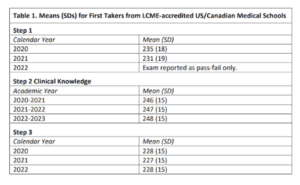Step 2 Percentiles: How to Understand & Interpret Your Score in a Step 1 Pass/Fail World
- by
- Mar 12, 2024
- Reviewed by: Amy Rontal, MD

[Dr. David Delnegro and Paige Mauriello contributed to this post]
Originally published January 2021, updated March 2024
For a moment, let’s imagine it’s a beautiful sunlit day somewhere very far from your computer screen. You decide to engage in a friendly game with a street vendor guessing where a stone is hidden in his cups.
You play once, twice, three times, and every time it’s in the left cup. Fourth game, you guess the left cup because you’re no fool.
But, alas! He noticed your leanings and switched it to the middle cup. He warns you your folly was in neglecting the middle cup.
Now, imagine he’s the Federation of State Medical Boards (FSMB) and the stakes of the game are your future as a physician!
As you know, the FSMB recognized the long time emphasis placed on Step 1 of the USMLE and the overemphasis placed on the USMLE as a whole—and in an attempt to make what they believe will be positive change, they voted to change Step 1 to pass/fail in January 2022.
So, two years later, how has a Step 1 pass/fail world affected how you understand and interpret your Step 2 score? In this post, we’ll discuss some outcomes of Step 1 changing to a pass/fail exam and what qualifies as a “good” Step 2 score. Let’s dive into it!
 Preparing for Step 2? Meet the new combined Step 2 & Shelf Exams Qbank with 5,000 practice questions that most closely match what you’ll see on your USMLE Step 2 and all of your shelf exams. Get started with a 7-day free trial!
Preparing for Step 2? Meet the new combined Step 2 & Shelf Exams Qbank with 5,000 practice questions that most closely match what you’ll see on your USMLE Step 2 and all of your shelf exams. Get started with a 7-day free trial!
Why Did Step 1 Change to Pass/Fail?
It has been about two years now and we have seen how this has affected residency applicants and programs alike. Changing Step 1 to pass/fail has made Step 2 score the golden-child of residence placement, as it’s now the first one you can be numerically judged on from a national comparison standpoint.
This was apparently part of the goal, as Step 1 had initially been planned to be pass/fail in hopes of placing greater emphasis on the more clinical-science-based testing of Step 2 CK, which is more pertinent to clinical knowledge and an overall better indicator to how you will perform on Step 3 and your board exams.
The ultimate goal, perhaps, is to move the residency admission process away from a nearly unifactorial decision in Step 1 towards a multivariate one. It’s likely in the first several cycles following this change that Step 2 scores will simply replace Step 1 scores in the weight they carry in residence-placement. But the hope is that other factors such as the inclusion of shelf examinations into application material or the requirement and standardized evaluation of sub-internships will gain greater importance. Ideally, these major shifts will catalyze changes in both the UME and GME cultures. If you’re a first year medical student starting this fall of 2024, residency applications might look very different for you than they have for many years.
Outcomes of This Change
In this preliminary study to test what effects this scoring change may have, it was found that: “After the removal of USMLE step 1 points, 40% of all applicants decreased in rank, 35% remained the same, and 24% increased.” The conclusion from the study is that removing the Step 1 score allowed for room to judge based more on the core values of a residency program. This could even lead to limitations on the number of programs an applicant can apply to, presumably.
While the people making these changes hoped this shift would redirect some of the stress placed on the USMLE to the students’ academics as a whole, not everyone feels this will have the desired effect. The majority of orthopedic and internal medicine program directors that responded to this study felt the decision lacked transparency and will negatively impact allopathic students from less prestigious medical schools, osteopathic students, and international medical graduates to name a few.
Interpreting Your Step 2 CK Score
All that being said, it’s still helpful to consider where you should aim based on your preferred specialty. The most competitive specialties have required higher Step 1 scores in the past, so it’s safe to assume those competitive specialties like Dermatology now require high Step 2 scores where they cannot judge Step 1. You can find a list of more competitive specialities here. It’s important, however, to compare your score to data that’s no more than three years old, according to USMLE Interpretation guidelines. This is because the test, much like yourself, evolves overtime. You can see the “Norm Table” from the same interpretation guidelines below. Your score can range anywhere between 1 and 300.

The table below from the National Resident Matching Program (NRMP) can help you determine where you generally want to aim for Step 2 in your specialty to be as exceptional as we know you can be.
According to the NRMP, “USMLE Step 2 scores are a measure of an applicant’s ability to apply the medical knowledge, skills, and understanding of clinical science essential for providing patient care. Step 2 scores were available for only 59.0 percent of U.S. DO seniors who gave consent to research. Overall, U.S. DO seniors who matched to their preferred specialty had mean USMLE Step 2 CK scores of 241.1 (s.d. = 13.6) well above the 2022 minimum passing score of 209.”
You can see below how that compares to, say, Plastic Surgery, which averaged some of the highest scores for Matched students into the high 250s.
With USMLE Step 1 becoming pass/fail, and no matter your personal opinion of that move, it all ends up with one overarching consequence: the importance of Step 2 CK has just increased dramatically. As such, it is natural to have a lot of questions about how Step 2 CK is similar to—and different from—Step 1. First, let’s review the numbers so we can explain and demystify them.
Step 2 Percentiles: Side-by-Side Comparison with Step 1, Step 2 CK, and Step 3
| Score | Step 1 Percentile | Step 2 CK Percentile | Step 3 Percentile |
| 300 | 100 | 100 | 100 |
| 295 | 100 | 100 | 100 |
| 290 | 100 | 100 | 100 |
| 285 | 100 | 100 | 100 |
| 280 | 100 | 100 | 100 |
| 275 | 100 | 99 | 100 |
| 270 | 100 | 96 | 100 |
| 265 | 98 | 91 | 100 |
| 260 | 95 | 82 | 99 |
| 255 | 90 | 71 | 98 |
| 250 | 82 | 59 | 95 |
| 245 | 72 | 46 | 89 |
| 240 | 62 | 35 | 81 |
| 235 | 52 | 25 | 71 |
| 230 | 43 | 17 | 58 |
| 225 | 34 | 12 | 45 |
| 220 | 26 | 7 | 32 |
| 215 | 19 | 4 | 22 |
| 210 | 14 | 3 | 13 |
| 205 | 10 | 1 | 8 |
| 200 | 7 | 1 | 4 |
| 195 | 4 | 0 | 2 |
| 190 | 3 | 0 | 1 |
| 185 | 2 | 0 | 0 |
| 180 | 1 | 0 | 0 |
| 175 | 1 | 0 | 0 |
| 170 | 1 | 0 | 0 |
| 165 and below | 0 | 0 | 0 |
Data based on Step 2 CK scores from July 1, 2017 to June 30, 2020; Step 1 and Step 3 scores based on data from January 1, 2017 to December 31, 2019. Sourced from USMLE.org.
As you can see above, Step 2 CK is right-shifted from Step 1 and even Step 3, meaning you need a higher Step 2 CK score to pass and a higher score to be competitive.
This chart displays the average step scores per year:
For Step 1, the concepts are difficult but often much more abstract, and students have usually not been exposed to a wide variety of pathology yet.
For Step 3, most matched residents not attempting to apply to fellowship are riding the ‘P=MD’ or ‘70=DO’ train pretty hard and there is little incentive to do more than pass.
Step 2 CK tends to be the highest-scoring exam because students are never more competent in clinical knowledge for a wide variety of specialties than they will be at the end of their third year of medical school. Additionally, students have been sharpened by shelf exams digging deeper into the details for each speciality than the preclinical years.
Classically, one likes to do ‘slightly better’ on Step 2 CK than they do Step 1, but for those who have not gotten the score they wanted on Step 1, Step 2 CK provides a major opportunity to make a statement right before applications go out.
I have several friends who had mental or physical ailments provide a roadblock on Step 1 only to absolutely kill it on Step 2 CK and match into some very good specialties in some very competitive places.
What is the Step 2 CK Passing Score?
The USMLE Management Committee conducted a review of the USMLE Step 2 CK passing standard and decided that a five-point increase—used to determine a Pass or Fail outcome—will apply to Step 2 CK examinees testing on or after July 1, 2022.
On the three-digit score scale, the passing standard changed from 209 to 214.
What Qualifies as a “Good” Step 2 CK Score?
Based on recent data, the 50th percentile corresponds to around 245, and all but those trying to compete for very competitive specialities or very competitive locations can feel generally happy with a score around the top of the bell curve. The 75th percentile corresponds to around 258 and at this point, anything above that is gravy.
The 25th percentile corresponds to around the score 235. Most students should aim to have this as their floor, if possible, especially international medical graduate students.
A “good” score depends on your individual profile, what specialty you want to apply to, where you want to apply, and what school you attend.
For example, consider the somewhat exaggerated case of two similar students trying to match into a general surgery residency:
Student #1 is in a US MD school trying to apply to rural residencies in the Midwest and Southeast.
Student #2 is in an IMG school trying to apply to residencies in his home state of California.
Student #1 has inherent advantages in his school profile and is attempting to apply to an area that is traditionally less competitive. Student #2 has a higher ladder to climb as an IMG and is attempting to match into a very competitive environment. The former student likely only needs to approach the top of the bell curve to feel fairly comfortable moving forward, while the latter has a lower risk tolerance because a score below their desired range may prove to be difficult to overcome.
What Step 2 CK Score Do I Need to Secure Residency Interviews?
The mean Step 2 CK score for United States MD seniors who matched into residency in their preferred specialty in 2022 was 248, so you can consider this number a general ballpark for your target score.
But remember, that this is the mean score and not a minimum! We discuss this in greater detail below.
Furthermore, there is not much difference in Step 2 scores for matched and unmatched grads. Get this: of those MD seniors who did not match, the average Step 2 score was 242 (just 6 pts below those who matched). These statistics provide valuable insight, demonstrating the Match is more than just a score.
From Program Directors
According to the 2022 NRMP Program Director Survey, the mid-230s was the mean Step 2 CK score which nearly guarantees an interview.
Additionally, the majority of program directors stated that they would consider applicants’ Step 2 CK scores as part of their overall competitiveness.
As mentioned above, there are several factors involved in what your Step 2 CK score should be: your goal, your stretch goal, and your floor score where you do not proceed to take the exam.
Additional Data
The NRMP offers Step 2 CK score data by specialty for matched and unmatched applicants. These tables are great guides, but not all encompassing. Applicants with scores below the average Match score match all the time (otherwise it would be the minimum matching score not the average match score). And those with strong scores do occasionally get dealt an unlucky hand come application time. Use these as a guide and in concert with an advisor from your school, a mentor from your specialty, or one of the tutors working with you at Blueprint.
To take a ten-thousand foot view, one would love to have a score around the 66th percentile for their specialty and situation. For all Step 2 CK test takers in general, the 66th percentile corresponds to around 250.
If I “Did Well” on Step 1, Should I Care About Step 2 CK?
In a word, YES!
One of the most common things we hear about Step 2 CK is, “If I did well on Step 1, I can take it easy for Step 2 studying?”
The world we live in today is very different, and Step 2 CK is used by program directors as an important stratification point. Step 2 tests different knowledge and skills than Step 1 does so you should prepare well for what is now the most important exam in regards to your residency application.
The Big Picture
At the end of the day, it’s important not to fixate so much on numbers. Of course, that’s easier said than done when it feels like your future as a physician now rides on just one 3-digit score.
That’s not exactly the case, however. Your future is built on where you go to medical school, what research you get excited about and involved in, and which extracurriculars you engage in, along with your letters of recommendation. It is built on how you choose to set yourself apart and not on how focused you were on one single exam for all of medical school.
This is not a game of you v.s. USMLE. It’s the journey of becoming a physician who cares for humans when they are at their most vulnerable. All this to say, prepare for the USMLE as best you can, but don’t conflate a number with your drive, determination, and value as a future physician.
If that wasn’t enough to encourage you, don’t forget that you will have had the enormous challenge of Step 1 under your belt before you will need to tackle Step 2. And by Step 2, you’ll already have some experience to make your exam more like recalling information and less like memorizing a textbook. As always, we’re here to help you plan your studies and stay on track!
Looking for more (free!) content to help you pass Step 2 CK? Check out these other articles on the Med School blog:
About the Author
Mike is a driven tutor and supportive advisor. He received his MD from Baylor College of Medicine and then stayed for residency. He has recently taken a faculty position at Baylor because of his love for teaching. Mike’s philosophy is to elevate his students to their full potential with excellent exam scores, and successful interviews at top-tier programs. He holds the belief that you learn best from those close to you in training. Dr. Ren is passionate about his role as a mentor and has taught for much of his life – as an SAT tutor in high school, then as an MCAT instructor for the Princeton Review. At Baylor, he has held review courses for the FM shelf and board exams as Chief Resident. For years, Dr. Ren has worked closely with the office of student affairs and has experience as an admissions advisor. He has mentored numerous students entering medical and residency and keeps in touch with many of them today as they embark on their road to aspiring physicians. His supportiveness and approachability put his students at ease and provide a safe learning environment where questions and conversation flow. For exam prep, Mike will help you develop critical reasoning skills and as an advisor he will hone your interview skills with insider knowledge to commonly asked admissions questions.











